Source:TopHash
Compiled & Edited by:Janna, ChainCatcher
Editor’s Note
This article is based on the latest research report published by Tophash Digital, a consulting investment company in the digital asset field, in July 2025. The report showcases the profound changes occurring in the cryptocurrency exchange listing landscape from 2024 to the first half of 2025. Binance continues to lead with Alpha airdrops and IDOs, the rise of secondary listings shows better performance than initial listings, on-chain issuance and perpetual contract listings are becoming new trends, and there are significant differences in listing strategies, project performances, and paths among different exchanges. This article will reveal the dynamics of exchange listings from multiple dimensions, including activities, performances, and distributions.
ChainCatcher has organized and compiled the content (with some omissions).
This research provides a comprehensive analysis of the listing dynamics of cryptocurrency tokens in major centralized exchanges and Binance-related issuance plans from January 2024 to June 2025. The subjects of the study include several mainstream trading platforms, including Binance, Binance perpetual contract market, Coinbase, OKX, Upbit, Bithumb, and Bybit. The research scope covers spot, perpetual contracts, and issuance channels based on decentralized exchanges (DEX), focusing on two types of listing behaviors: initial listings (new assets directly allocated through mechanisms such as airdrops, i.e., Token Generation Events (TGE) or Initial Exchange Offerings (IEO)) and secondary listings (tokens that have trading history on other platforms being listed on a new exchange). This study systematically sorts out the listing trends of different exchanges, fully diluted valuation (FDV) distributions, post-listing performances of tokens, and cross-platform listing paths, with the core goal of gaining in-depth insights into Binance's dominant role as a core listing channel and comparing the strategies and performance differences of other platforms such as Coinbase, OKX, Upbit, Bithumb, and Bybit. Ultimately, it aims to reveal the diverse models and intrinsic mechanisms of token issuance, price performance, and market expansion in different liquidity environments.
- Listing Activities of Exchanges
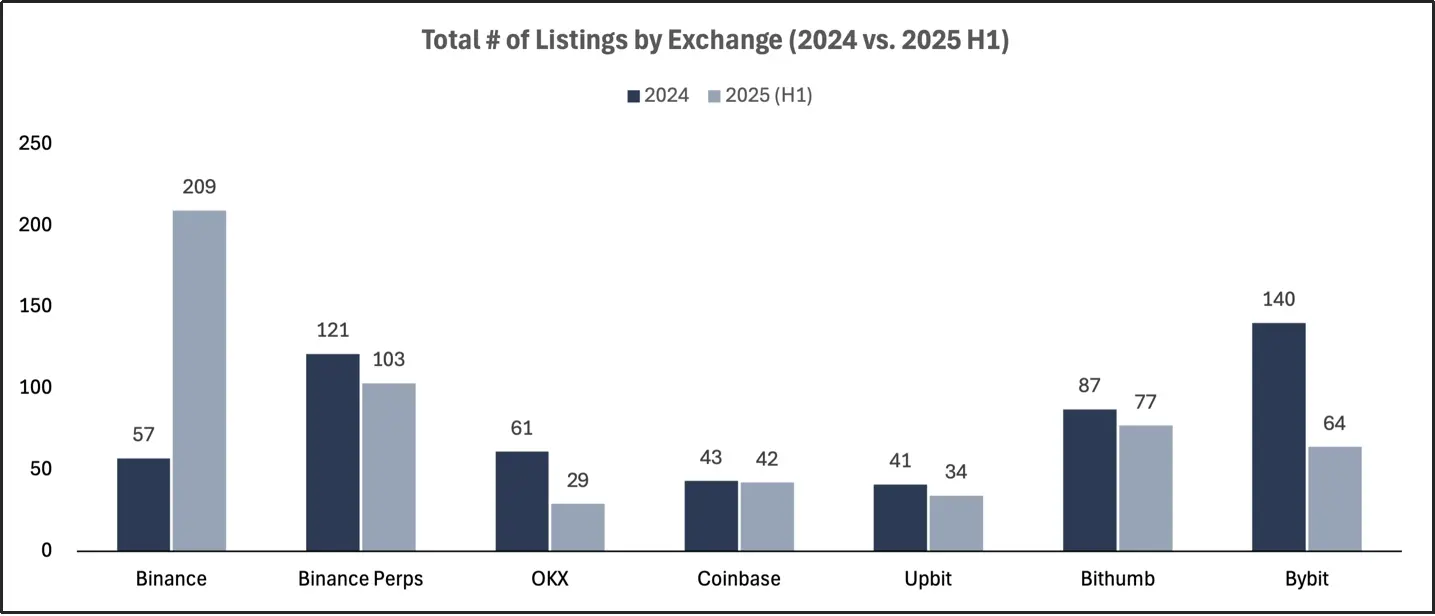
Total number of listings by exchanges in 2024 and the first half of 2025
In the first half of 2025, the listing activities of cryptocurrency exchanges significantly increased, but initial listings and secondary listings exhibited distinct development paths. Binance has significantly expanded its token listing ecosystem through its DEX-based issuance business and the continuous expansion of its perpetual contract market; in contrast, the listing pace of several other mainstream exchanges has slowed down or remained stable, showing a trend of centralization.

Number of initial and secondary listings by exchanges in 2025
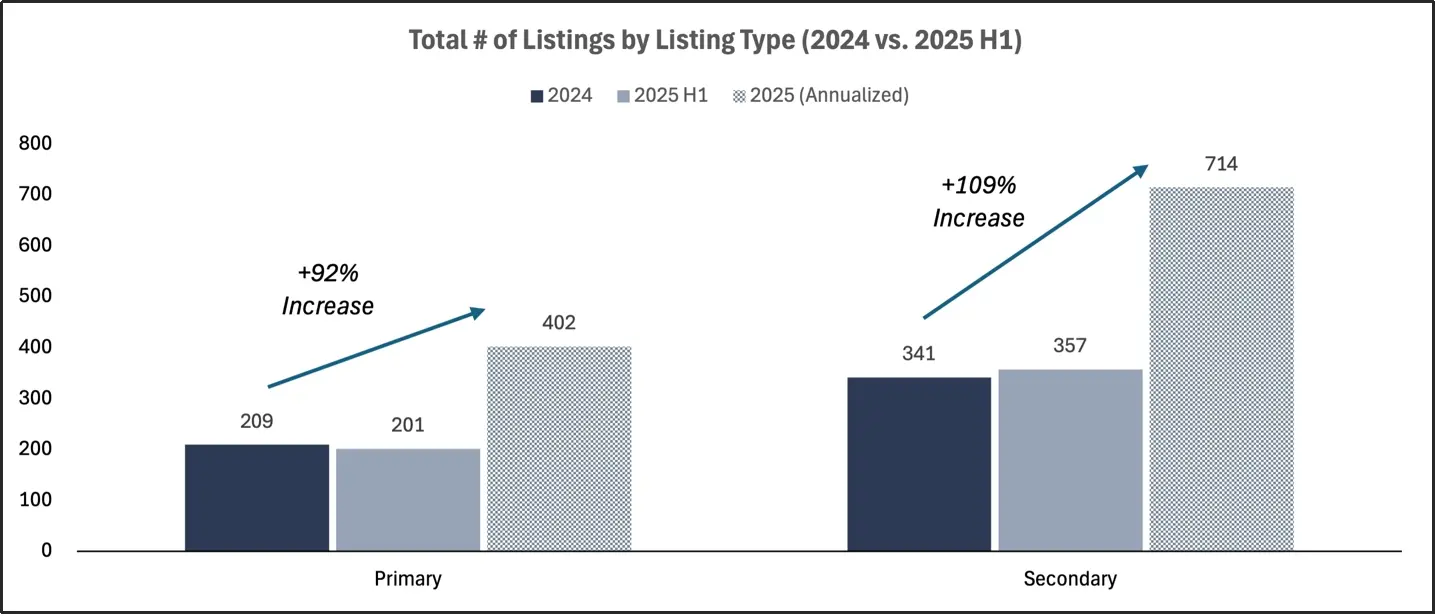
Total number of listings by exchanges in 2024, the first half of 2025, and projected for the entire year of 2025
In the first half of 2025, Binance remained the most active exchange globally for initial listings, launching 71 initial listing projects, all driven by DEX issuance channels, specifically including airdrops from the token discovery platform Binance Alpha and initial decentralized offerings (IDOs). Upbit and Coinbase maintained a relatively stable pace for initial listings, each launching about 12 projects in the first half of the year, primarily consisting of mainstream cryptocurrencies with larger market capitalizations. In contrast, Bybit and OKX have significantly reduced the scale of initial listings, with numbers dropping from double digits in 2024 to single digits in the first half of 2025. Overall, the number of initial listings in the industry is expected to increase significantly, from 209 in 2024 to 402 in 2025, a year-on-year increase of 92%; this growth is mainly driven by decentralized issuance methods such as Binance Alpha and IDOs.
Regarding secondary listings, Binance launched a total of 138 secondary listing projects during the same period, with the vast majority being re-listed existing tokens promoted through the Binance Alpha platform. Coinbase, Upbit, and Bithumb also focused more on secondary listings, which accounted for about 80% of their total listings in 2025. The Binance perpetual contract market also showed a clear preference for secondary listings, with their number nearly double that of initial listings. The total number of secondary listings is expected to achieve a year-on-year growth of 109%, rising from 341 in 2024 to 714 in 2025. Under the leadership of Binance and its Alpha program, secondary listings are rapidly becoming the dominant form of listing activity in exchanges in 2025.
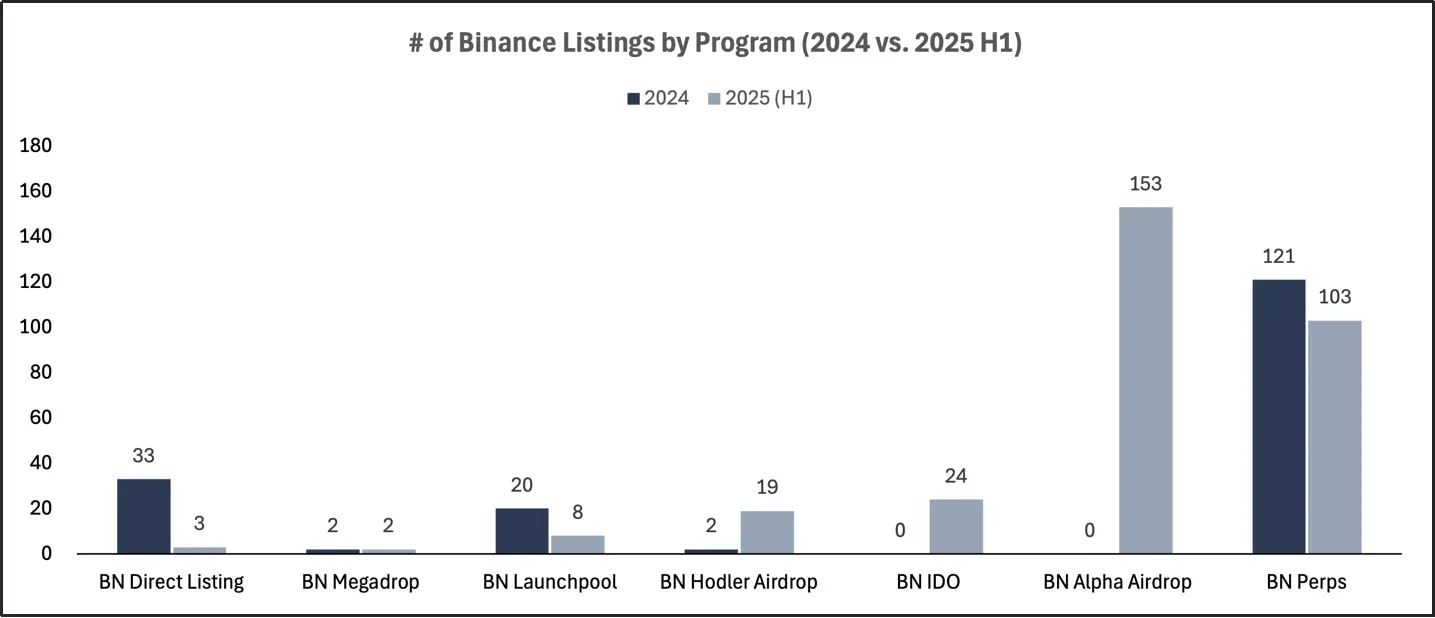
Number of Binance listings categorized by project in 2024 and the first half of 2025
In Binance's new token generation events (TGE), Alpha airdrops and IDOs dominated, contributing a total of 84% of new asset issuance. From an annual comparison, the overall spot listing plans remained stable: 64 are expected in 2025, roughly on par with 57 in 2024, covering various issuance methods such as direct listings, Launchpool, Megadrop, and holder airdrops.
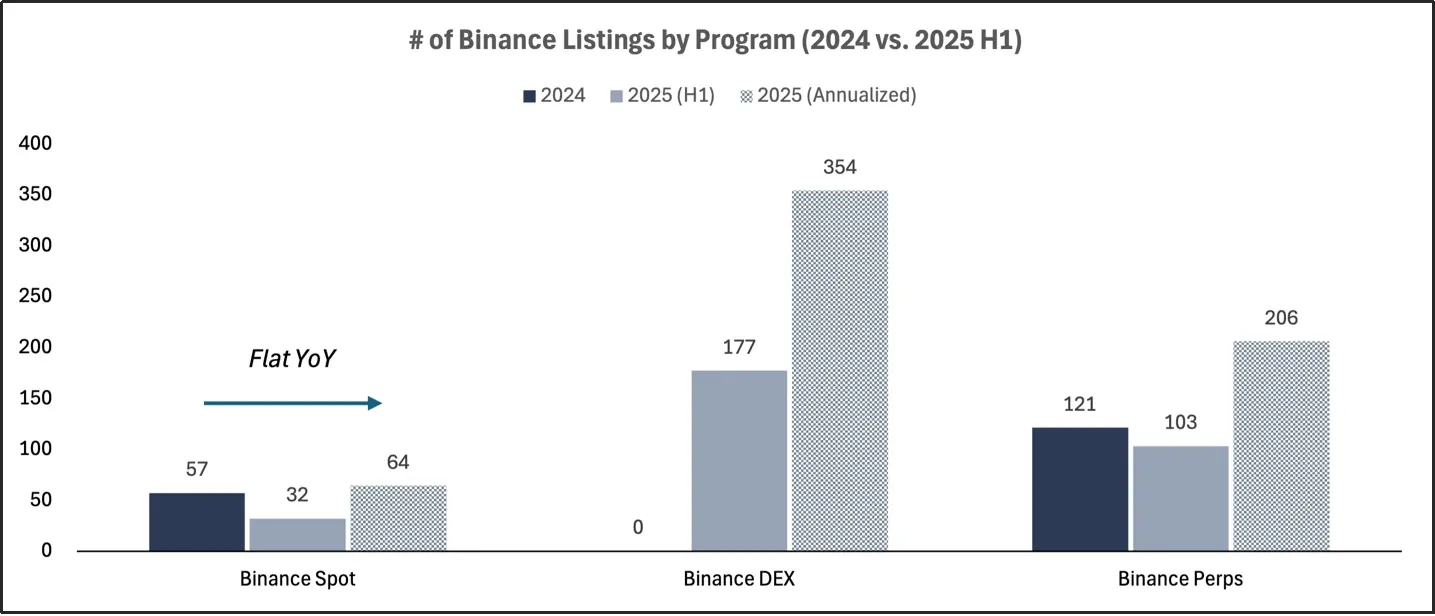
Number of Binance spot, decentralized exchange, and perpetual contract listings in 2024, the first half of 2025, and projected for the entire year of 2025
In Binance's futures listing projects, secondary listings dominated. Among the 103 projects launched in the first half of 2025, 72 were secondary listings, which continued to bring strong trading volumes but had limited impact on driving new token generation events (TGE). Currently, Binance's listing strategy has clearly shifted to focus on DEX issuance, while traditional spot listing mechanisms still maintain strict review and control.
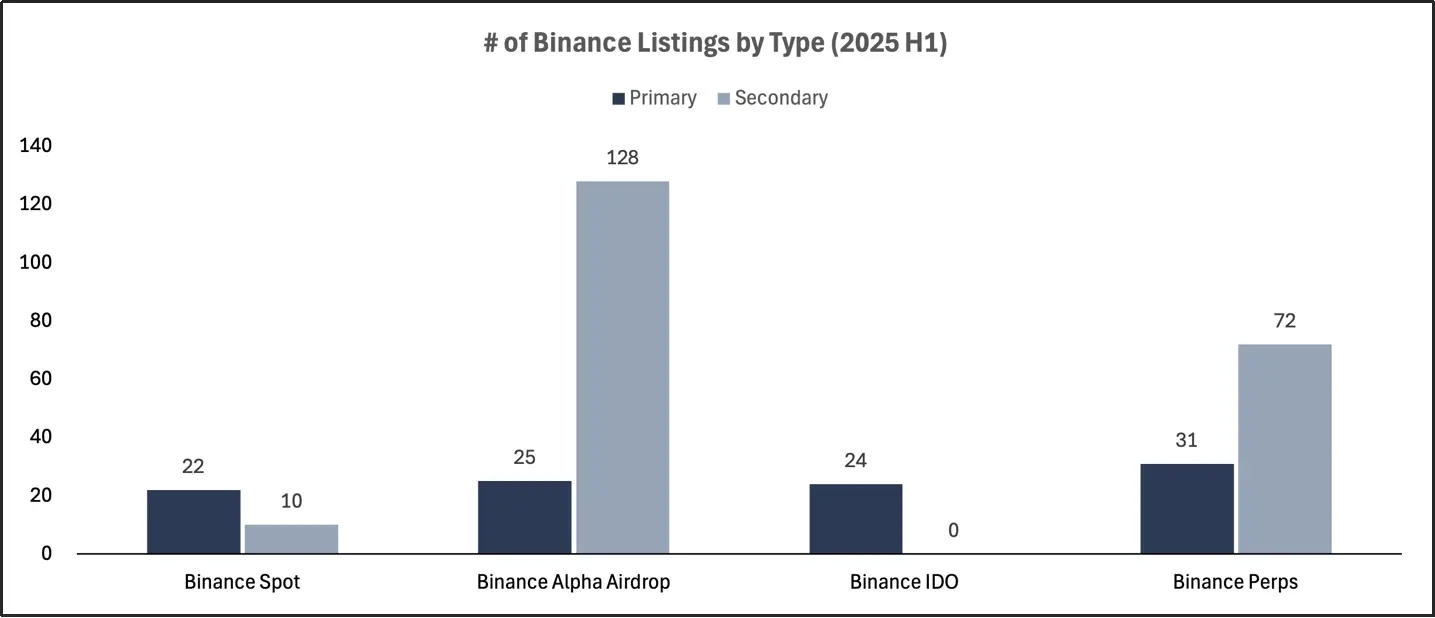
Number of initial and secondary listings by Binance in the first half of 2025
- Listing Performance of Exchanges
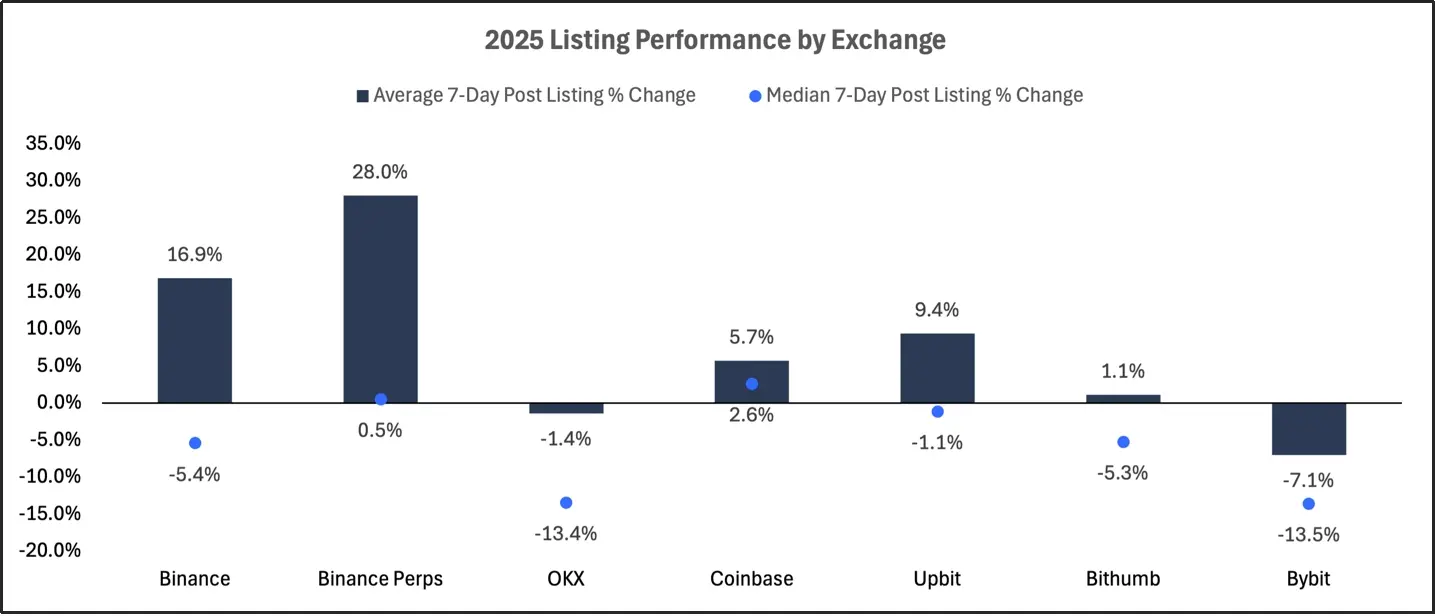
Token performance of listings on exchanges within 7 days in 2025
The seven-day performance data of exchange listing projects shows a significant differentiation between initial listings and secondary listings. On almost all platforms, tokens from initial listings performed poorly, with both average returns and median returns falling into negative territory after the token generation events (TGE). In contrast, secondary listings generally exhibited stronger and more stable positive returns, primarily due to their existing market consensus and liquidity foundation.
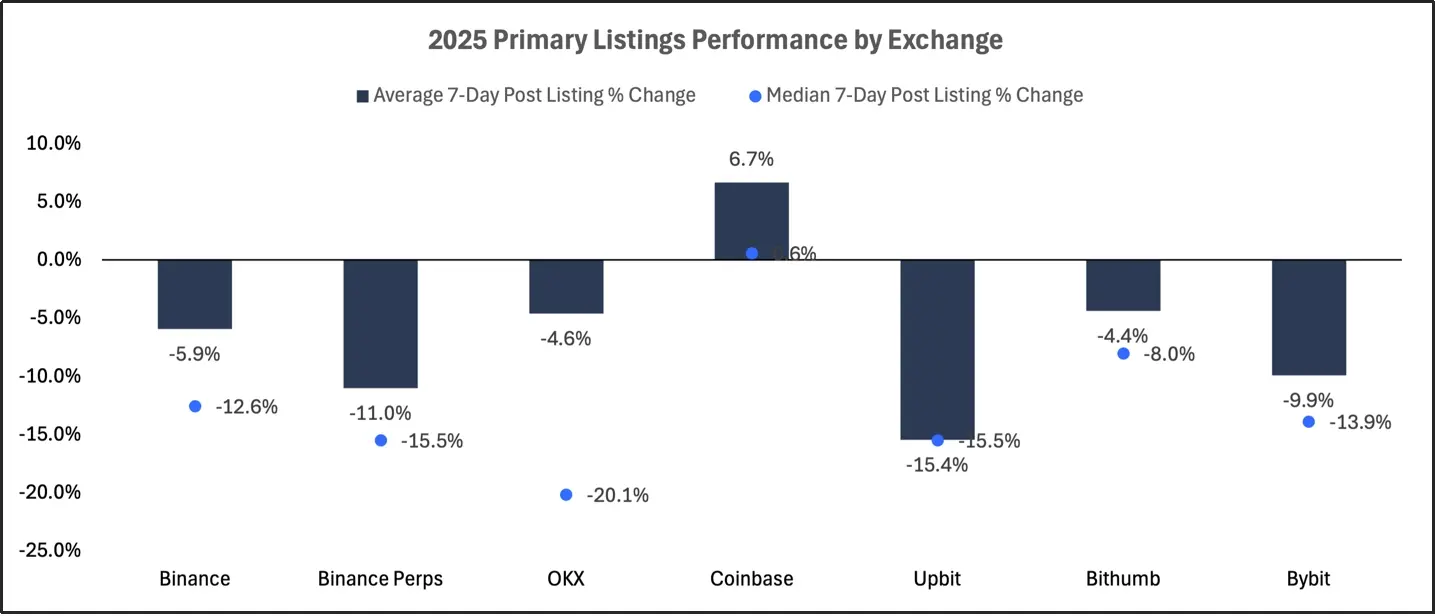
Token performance of initial listings within 7 days in 2025
The new coin listing projects on the main boards of various exchanges generally performed poorly, recording negative returns across the board over the past seven days. Although Coinbase showed a slight average positive return (+6.7%), its median return remained flat, indicating insufficient upward momentum. The performance of new coins listed through Binance's spot, Alpha airdrops, and IDO channels fell short of expectations, with median return rates ranging from -5% to -19%. Exchanges such as OKX, Bithumb, and Upbit also showed continued losses, with average return rates between -4% and -15%. Overall, regardless of the exchange or project channel, new coins seem to face the pressure of being sold off immediately after listing.
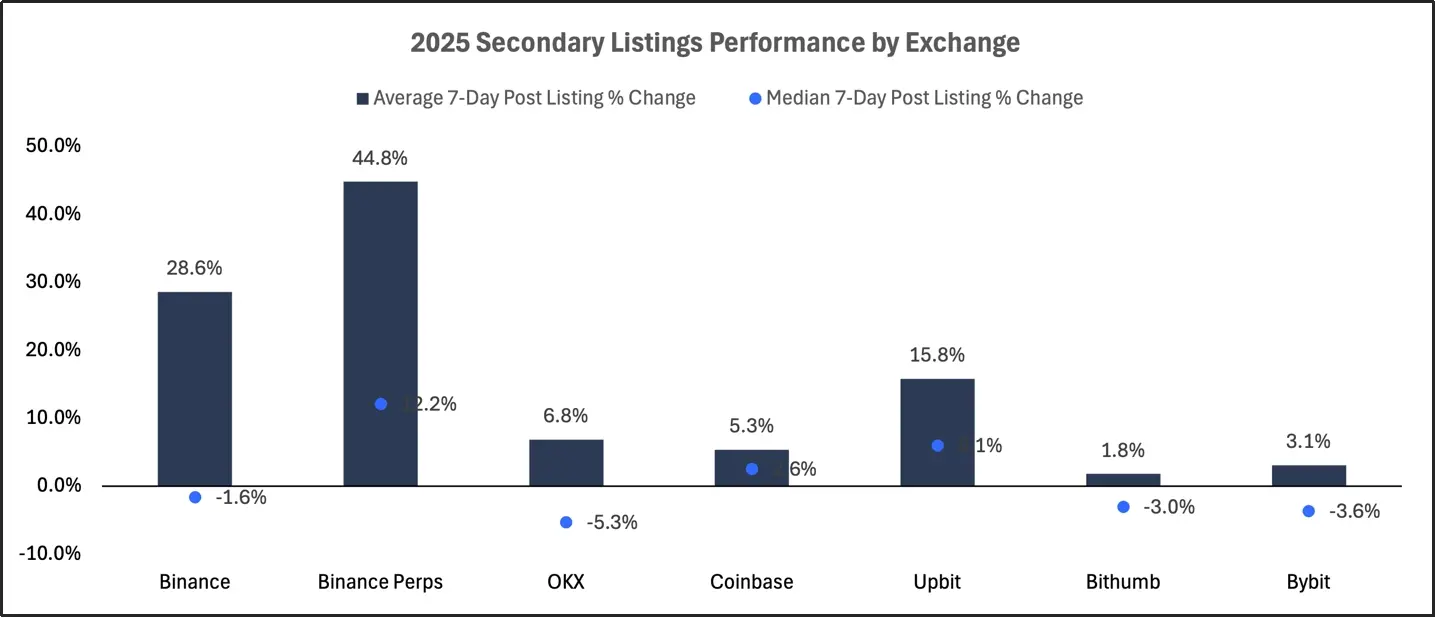
Token performance of secondary listings within 7 days in 2025
The token performance within 7 days after listing shows a clear difference between initial and secondary listings. In almost all exchanges, initial listings performed poorly, with both average return rates and median return rates being negative after the token generation events (TGE). In contrast, secondary listings often bring stronger and more stable returns, benefiting from their existing market recognition and liquidity.
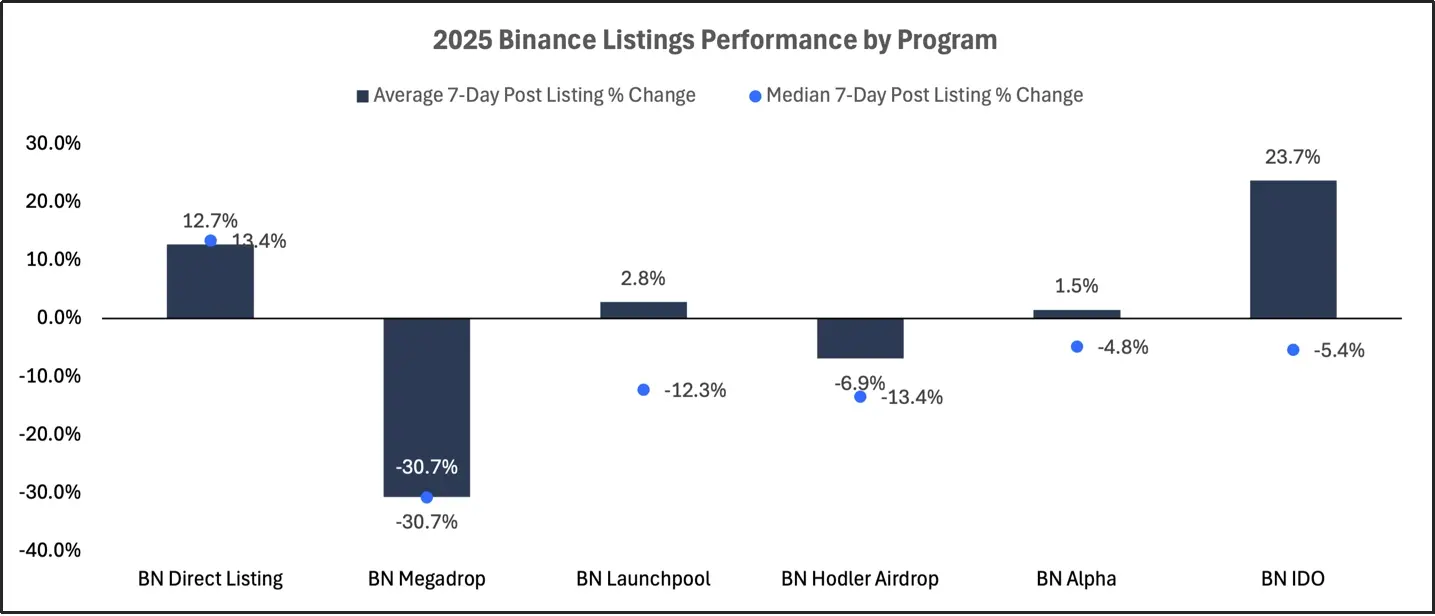
Token performance of Binance projects within 7 days of listing in 2025
The average return rate of initial decentralized exchange offerings (IDOs) was +1.5%, but the median of -4.8% highlights the limited coverage of successful cases. The performance of initial listings from Alpha airdrops ranked among the worst, with an average return rate of -11.2% and a median of -13.8%. The average return rate of initial spot listings was -8.0%, with a median of -19%, ranking at the bottom among all projects. The performance of secondary listings in both spot and futures was better than their corresponding initial listings, further confirming the notion that existing tokens perform better when listed on new exchanges than during their initial token generation events (TGE). The strongest post-listing performance on Binance has always been secondary listings, while initial issuances, especially those through Alpha and spot channels, generally performed poorly.
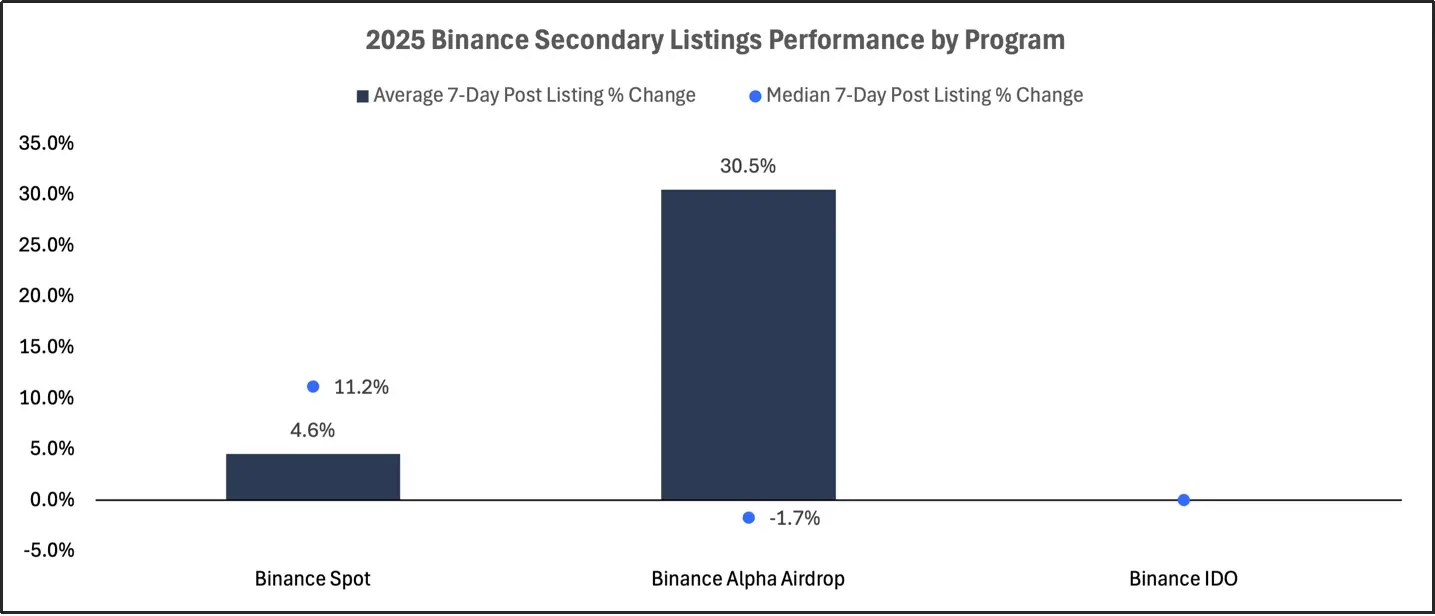
2025 Binance Project Secondary Listing Token Performance Within 7 Days
- Peak Fully Diluted Valuation (FDV) Ratio and Time Analysis
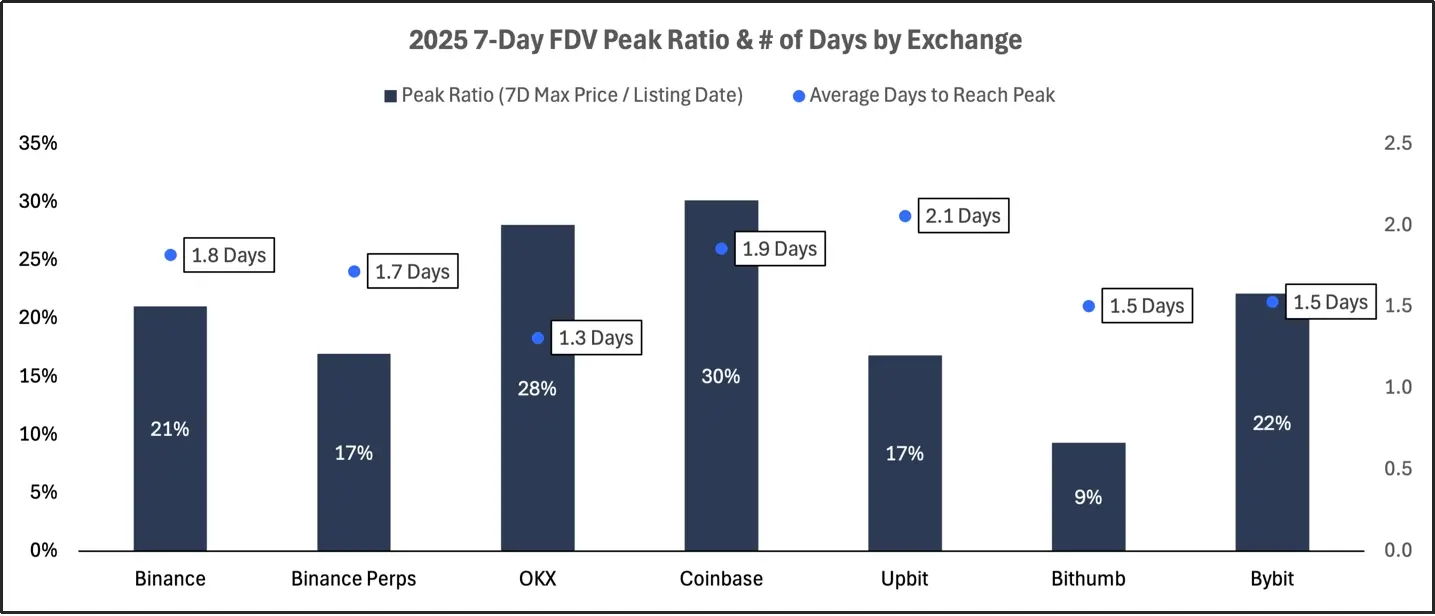
Peak FDV Ratios and Average Days to Peak for Each Exchange Within 7 Days in 2025
This section analyzes the peak fully diluted valuation (FDV) ratios and the average days required to reach those peaks. These metrics collectively reveal the dynamics of price discovery: a higher peak FDV ratio reflects stronger early demand and upward momentum, while a longer time to peak indicates sustained buying interest rather than initial speculation.
The calculation method for peak FDV ratios in this article is: the highest price within 7 days post-listing divided by the closing price on the day of listing.
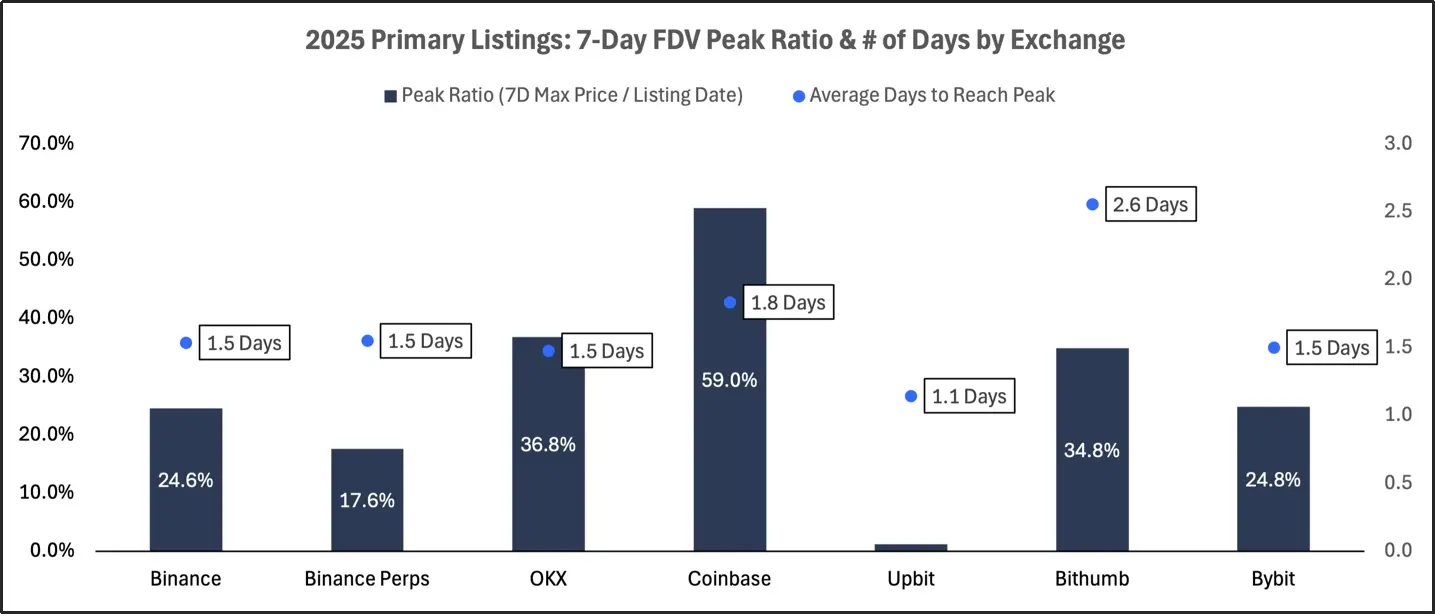
Peak FDV Ratios and Average Days to Peak for Initial Listings by Each Exchange Within 7 Days in 2025
Among initial listing projects, Coinbase and OKX performed the best, with peak FDV ratios reaching 59% and 37%, respectively, both achieving this in about 1.5 to 1.8 days. Binance's IDO channel for initial listings also performed strongly, with an average peak FDV ratio of 38%, reached in 2.1 days, reflecting sustained and stable market demand. In contrast, projects from Alpha airdrops and direct spot listings peaked earlier and at lower levels, with FDV ratios only at 17% to 18%, typically peaking within 1.1 to 1.3 days. Upbit and Bithumb's listing projects also surged quickly but showed significantly less follow-up momentum, indicating limited secondary market buying support. Overall, most initial listing projects quickly reached their peaks early on, with relatively limited upward potential.
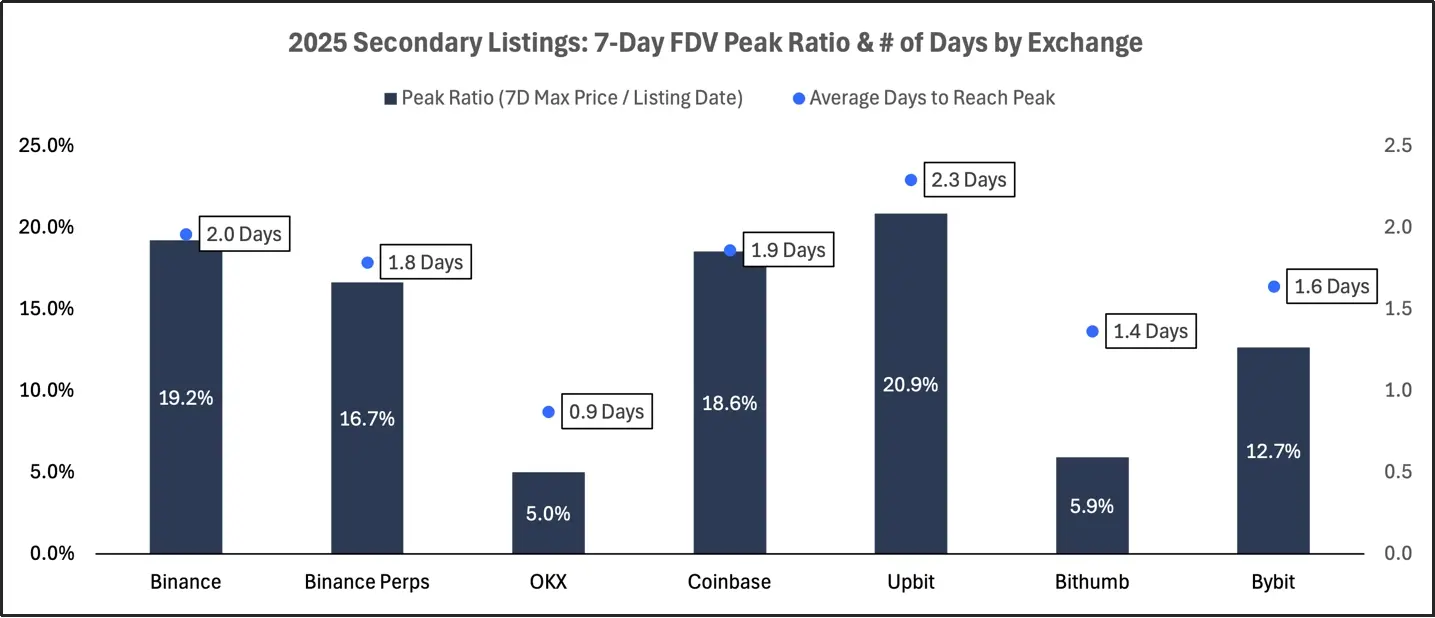
Peak FDV Ratios and Average Days to Peak for Secondary Listings by Each Exchange Within 7 Days in 2025
The peak performance of Binance's spot and Alpha secondary listings was robust (around 20%-30%), but Alpha secondary listings took longer to reach their peaks (2.1 days) and were more affected by extreme values. Upbit and Coinbase's secondary listings exhibited a similar trend, with peak FDV ratios of 18%-21% and reaching their peaks in about 2 days. OKX and Bybit's secondary listings peaked quickly but performed weakly, with less than 10% upward potential and reaching their peaks in less than 1.5 days. Overall, the price discovery curve for secondary listings is healthier and more stable.
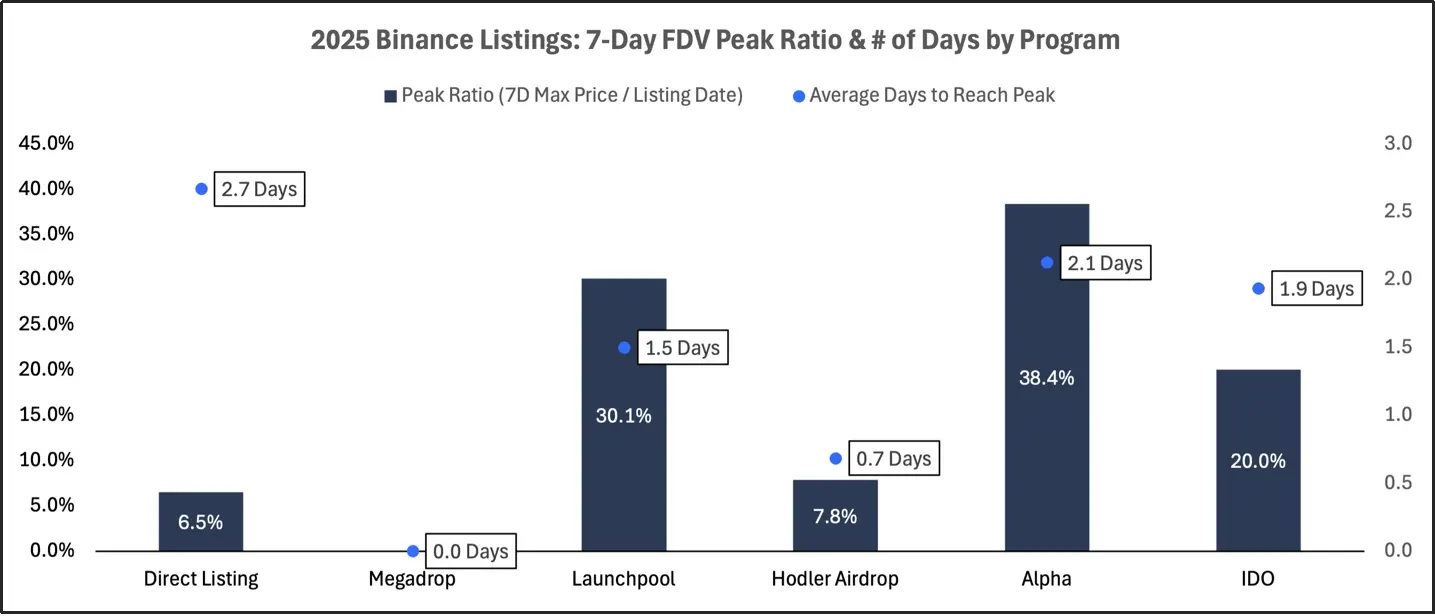
Peak FDV Ratios and Average Days to Peak for Binance Projects Within 7 Days in 2025
Binance's IDO initial listings achieved the highest peak FDV ratio (38%) among all projects and took the longest time to peak (2.1 days), indicating strong and sustained demand at the time of project launch. The peak for Alpha airdrop initial listings occurred earlier and at a lower level, with an FDV ratio of 17% within 1.3 days, suggesting that early momentum was more dominant. The performance of initial spot listings was similar to Alpha, with an average peak of 18%, and peaks often occurring on the first day of listing. The peak for Binance's spot secondary listings appeared quickly but was only 2%, with many projects reaching their peaks on the day of listing. Overall, the peak potential for Binance's spot listings is limited, and prices tend to drop quickly after reaching their peaks.

Peak FDV Ratios and Average Days to Peak for Binance Initial Listings Within 7 Days in 2025
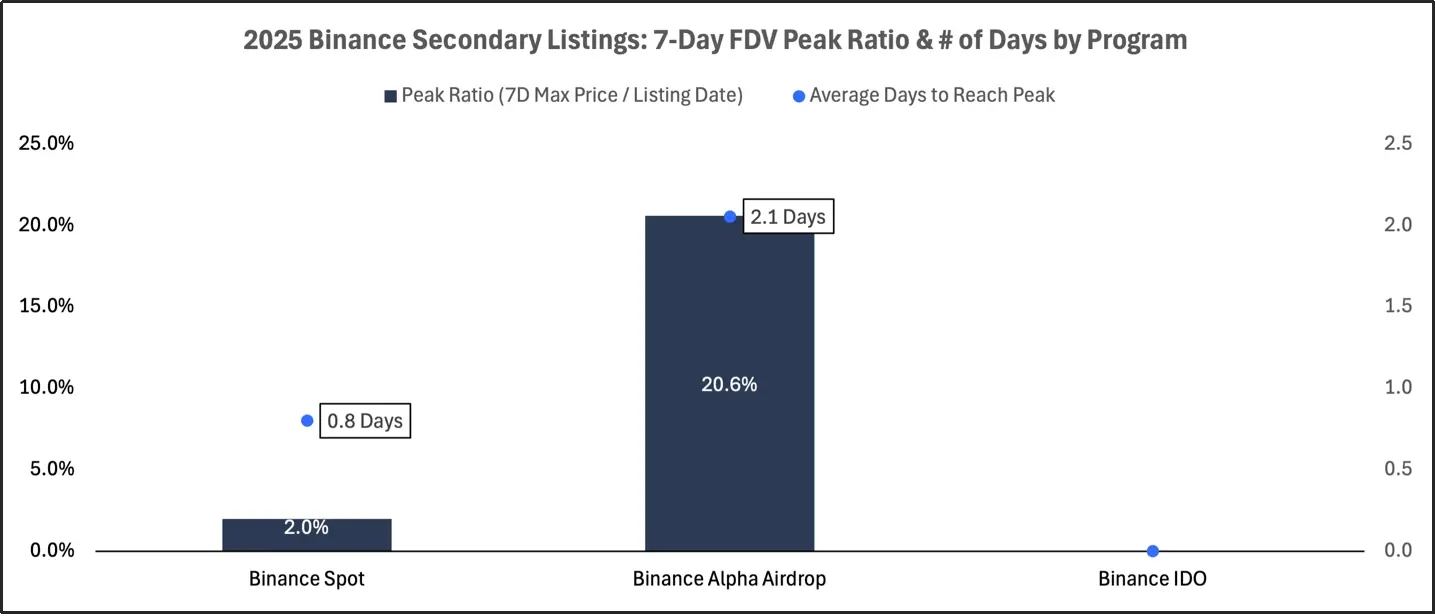
Peak FDV Ratios and Average Days to Peak for Binance Secondary Listings Within 7 Days in 2025
- Listing Situation by Fully Diluted Valuation (FDV) Distribution

Project Valuation Levels Based on Fully Diluted Valuation (FDV) Distribution by Each Exchange in 2024

Project Valuation Levels Based on Fully Diluted Valuation (FDV) Distribution by Each Exchange in 2025
This section will analyze the fully diluted valuation (FDV) of listed projects to assess how exchanges and listing plans categorize trading volume by project size. For initial listing projects, FDV is calculated based on the closing price on the day of listing; for secondary listing projects, FDV reflects the valuation prior to listing. By comparing various exchanges and Binance-related plans, we can identify the patterns of how listing platforms filter tokens and segment issuances across different valuation levels. The valuation levels are specifically categorized as: micro (under $75 million), small ($75 million–$250 million), medium ($250 million–$750 million), large ($750 million–$2 billion), and giant (over $2 billion).
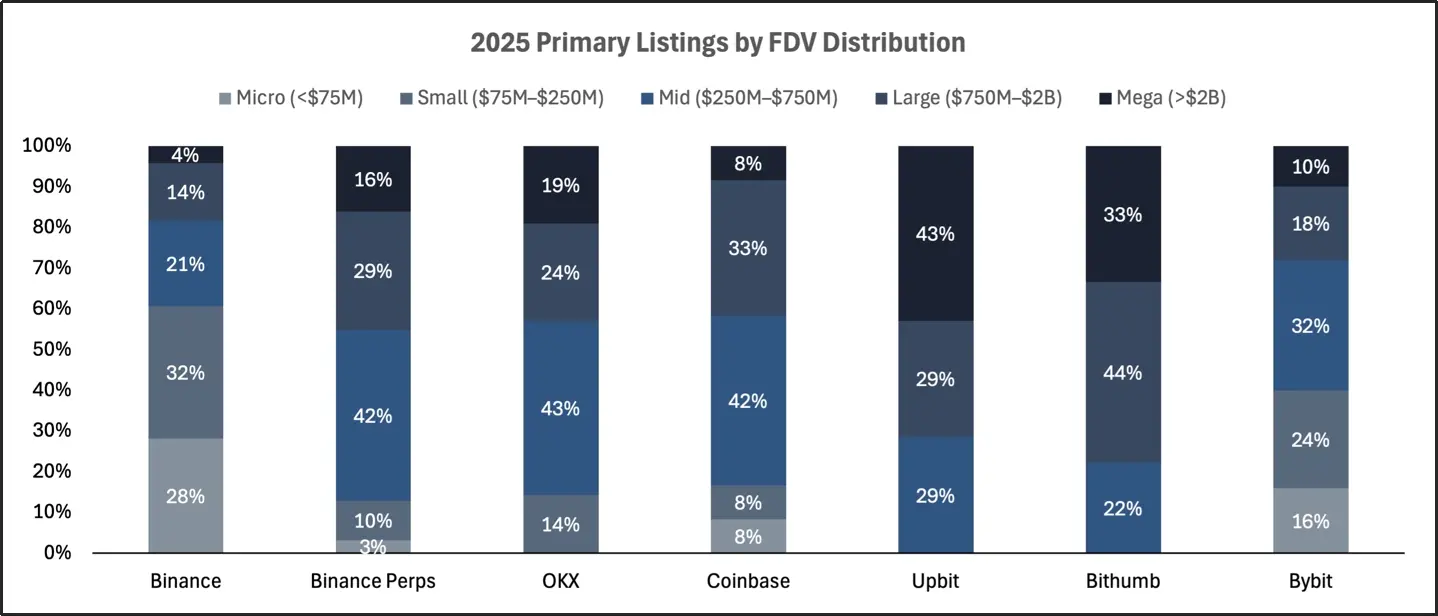
Ratios of Project Valuation Levels Based on Fully Diluted Valuation (FDV) Distribution by Each Exchange in 2024
Upbit and Bithumb's initial listing projects are heavily skewed towards large and giant caps, with projects having fully diluted valuations (FDV) over $750 million accounting for 72% and 77%, respectively, with Upbit alone having 43% of its projects classified as giant caps. Coinbase and OKX's initial listing projects are concentrated in the mid-to-large cap range, with 75% of projects having FDVs over $250 million, most falling between $250 million and $750 million. Binance's futures initial listing projects also tend to be high FDV types, with 87% of projects having FDVs exceeding $250 million. Bybit's distribution is the most balanced, with micro caps at 16%, small caps at 24%, medium caps at 32%, and large and giant caps combined at 28%. Overall, initial listing projects are typically dominated by high FDV projects, but in 2025, driven by Binance's DEX issuance plans, this trend has shifted towards low FDV projects.
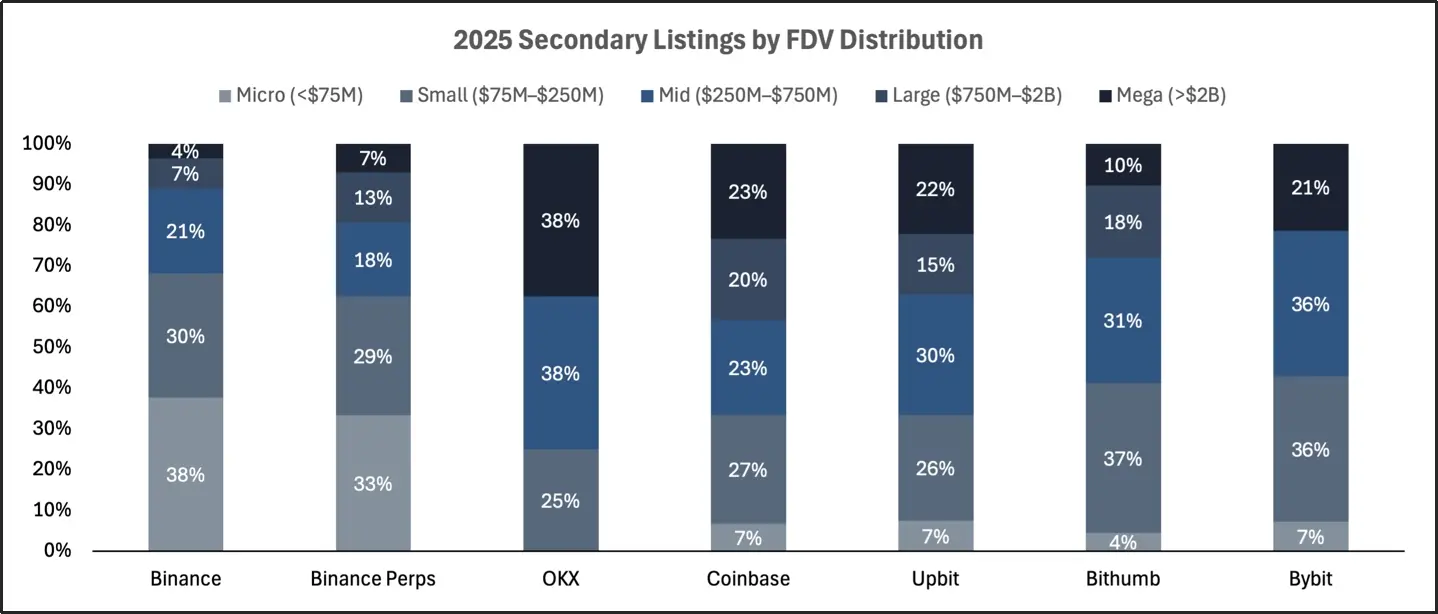
Ratios of Project Valuation Levels Based on Fully Diluted Valuation (FDV) Distribution by Each Exchange in 2025
Under the influence of Binance Alpha, Binance's secondary listing projects lean towards smaller scales, with fully diluted valuations (FDV) below $250 million. Bybit and Coinbase's secondary listing projects have a broader FDV distribution. The secondary listing projects from Korean exchanges, namely Upbit and Bithumb, are heavily skewed towards large projects. These patterns indicate that secondary listings provide a more flexible and accessible channel for projects of varying maturity.

Binance's Project Valuation Levels Based on Fully Diluted Valuation (FDV) Distribution in 2025
Binance's spot listing projects are skewed towards large caps, with no micro cap projects, and most projects have fully diluted valuations (FDV) over $250 million, concentrated above $750 million. Alpha airdrops target small cap projects, with about 80% of listing projects having FDVs below $250 million, and a high proportion of micro cap projects. Binance's IDO listing projects are concentrated in a narrow range, with almost all projects having FDVs between $75 million and $250 million, and none exceeding $750 million. Each of Binance's listing plans targets different market segments, with almost no overlap across FDV levels. Clearly, Binance's strategy is distinctly targeted: the spot segment focuses on scaled tokens, Alpha targets early projects, and IDOs are aimed at carefully selected growth-stage projects.

Binance's Initial Listing Project Valuation Levels Based on Fully Diluted Valuation (FDV) Distribution in 2025

Binance's Secondary Listing Project Valuation Levels Based on Fully Diluted Valuation (FDV) Distribution in 2025
- Binance's Listing Pathways
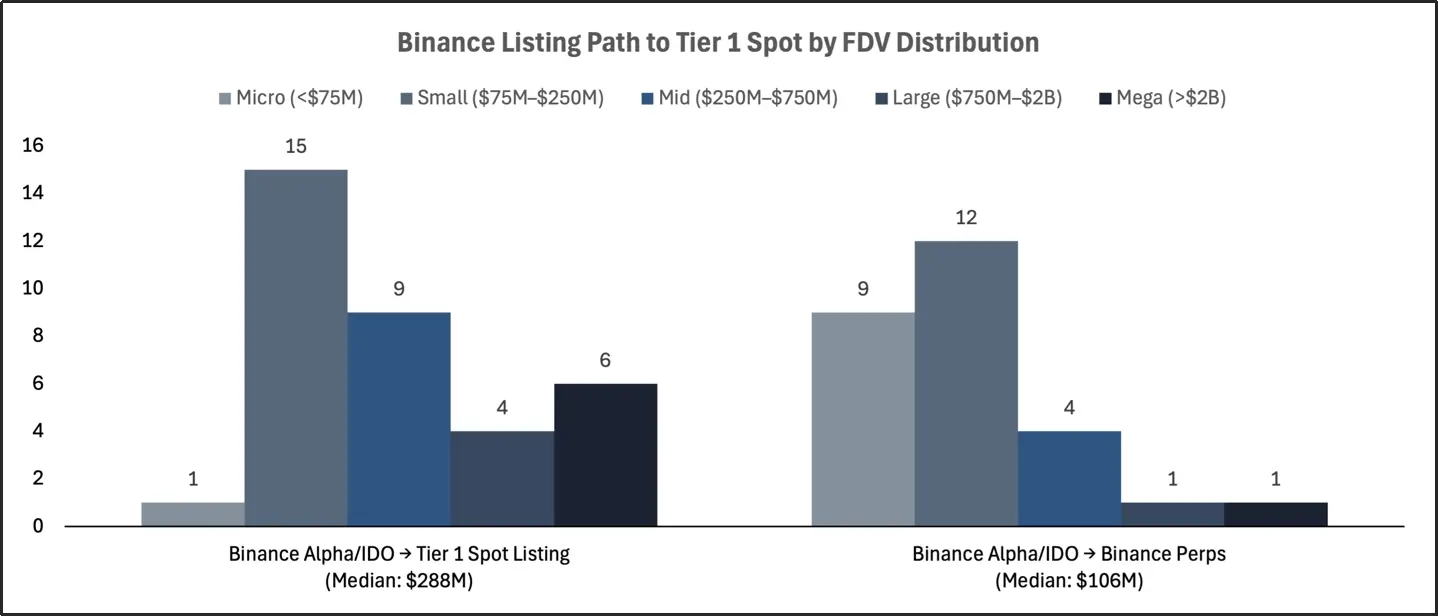
Binance's Listing Pathways for Top-Tier Spot Based on Fully Diluted Valuation (FDV) Distribution
This section will analyze the downstream listing pathways of Binance Alpha airdrops and Binance IDOs, tracking how these tokens subsequently land on Binance perpetual contracts, Binance spot, and other top-tier centralized exchanges (CEX) spot segments, such as OKX, Coinbase, Upbit, and Bithumb.
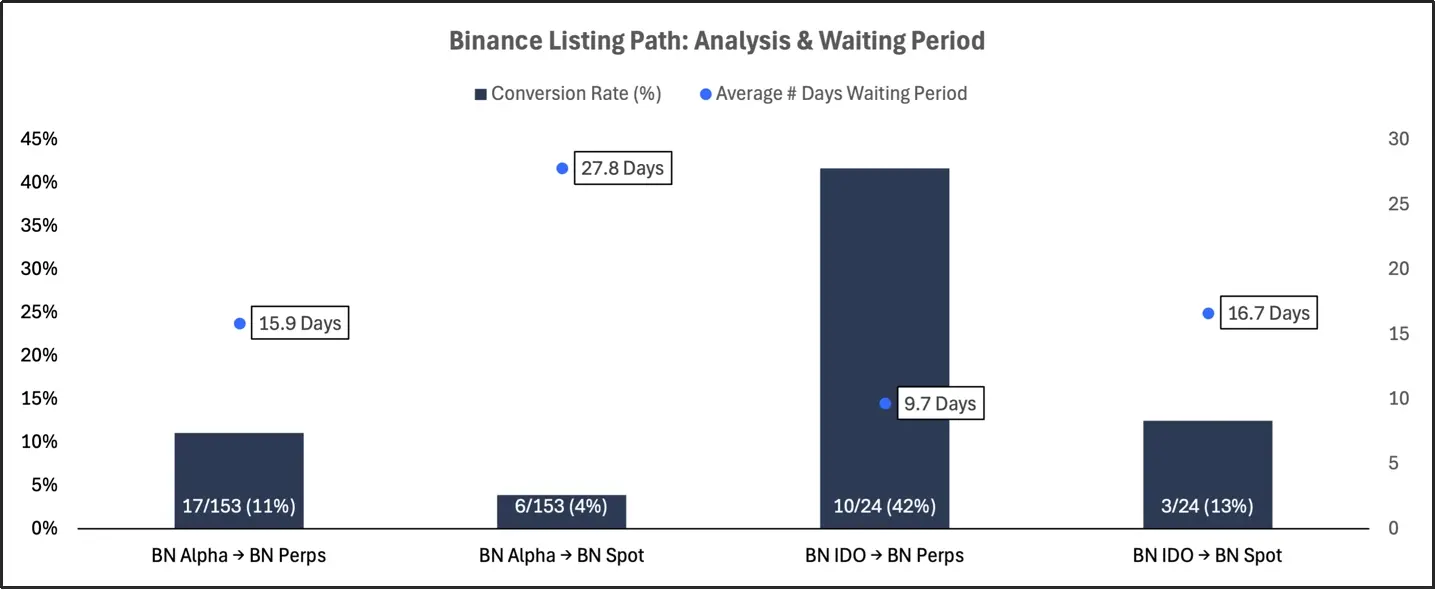
Binance's Listing Pathways: Conversion Rates and Average Waiting Days
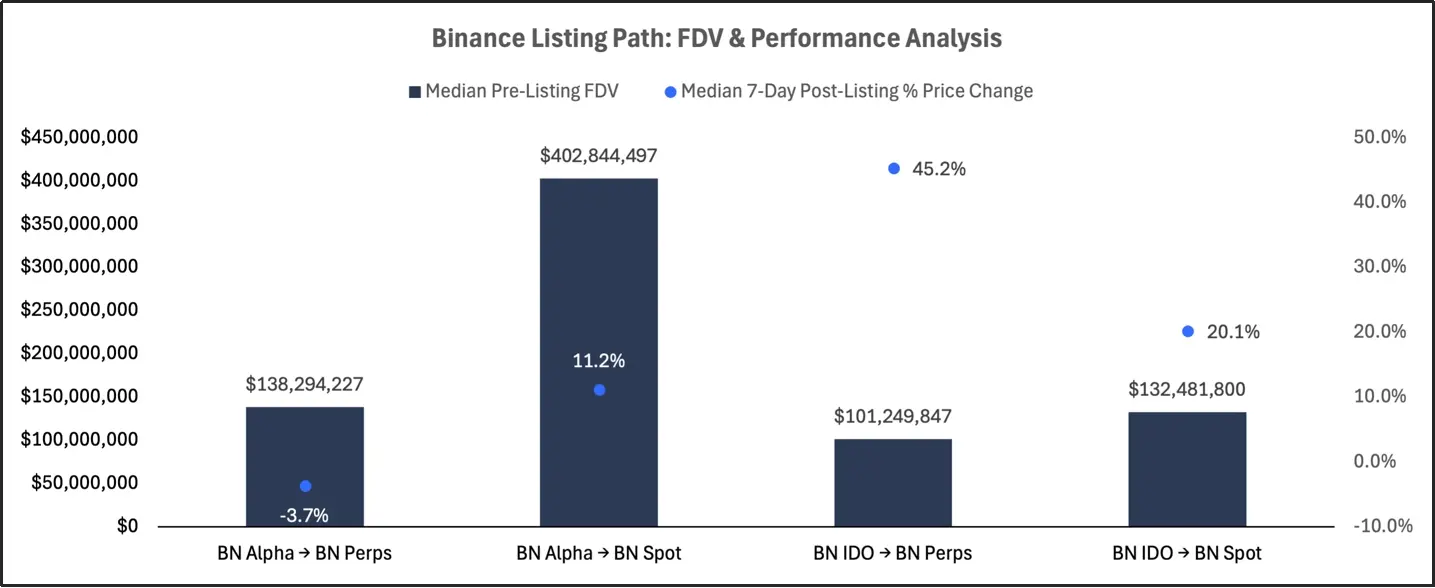
Binance's Listing Pathways: Fully Diluted Valuation (FDV) and Performance Analysis
Binance Alpha airdrops rarely advance to quality listing stages, with low conversion rates to perpetual contracts and spot markets, and generally lackluster performance post-listing; tokens that enter the spot market via Alpha are mostly high fully diluted valuation (FDV) projects, showing some subsequent performance. In contrast, Binance IDOs exhibit significantly stronger downstream appeal, especially in perpetual contract listings, with rapid advancement and impressive 7-day returns. Although IDO to spot transitions are not common, their performance still surpasses that of Alpha. Overall, Binance Alpha shows low downstream conversion and performance differentiation, while IDOs represent a stronger pathway to downstream listings (especially in perpetual contracts).
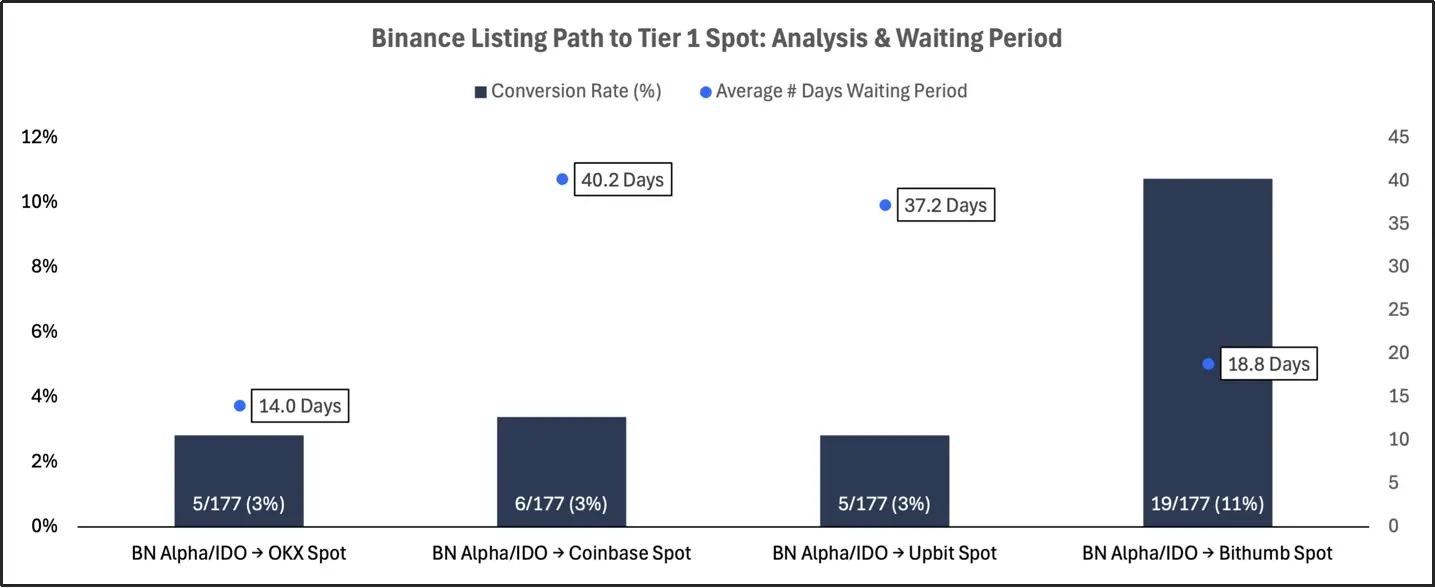
Binance's Top-Tier Spot Listing Pathways: Conversion Rates and Average Waiting Days
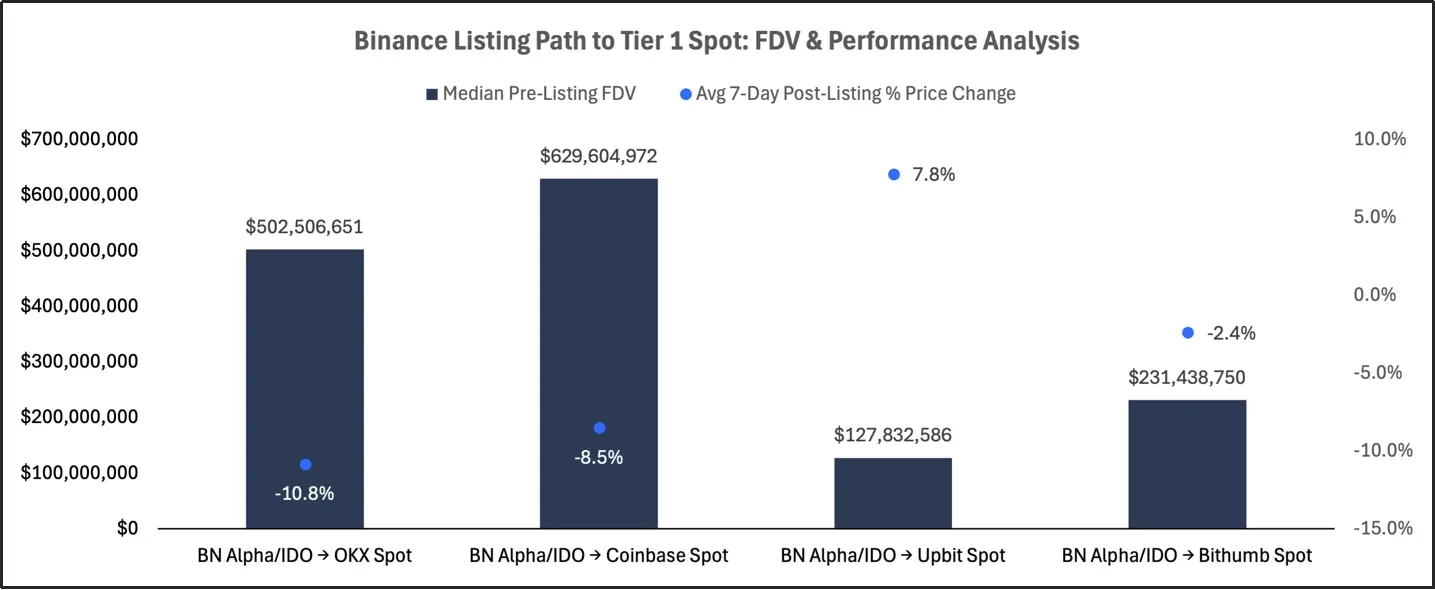
Binance's Top-Tier Spot Listing Pathways: Fully Diluted Valuation (FDV) and Performance Analysis
Among tokens issued through Binance Alpha or IDO, those that manage to list on top-tier exchange spot markets remain rare, with not only low conversion rates but also often long delays before these tokens appear on other mainstream exchanges. The performance of these tokens post-listing on other exchanges is generally poor, with most showing negative returns, and only a slight increase observed on Upbit. Such listings tend to favor large-cap tokens, further confirming the notion that projects with higher fully diluted valuations (FDV) are more likely to secure listings on more top-tier exchanges. While listing on external exchanges can provide broader exposure, this conversion is not only rare but often underwhelming, especially for high FDV projects, whose liquidity events are more likely to be used for token distribution rather than project growth.
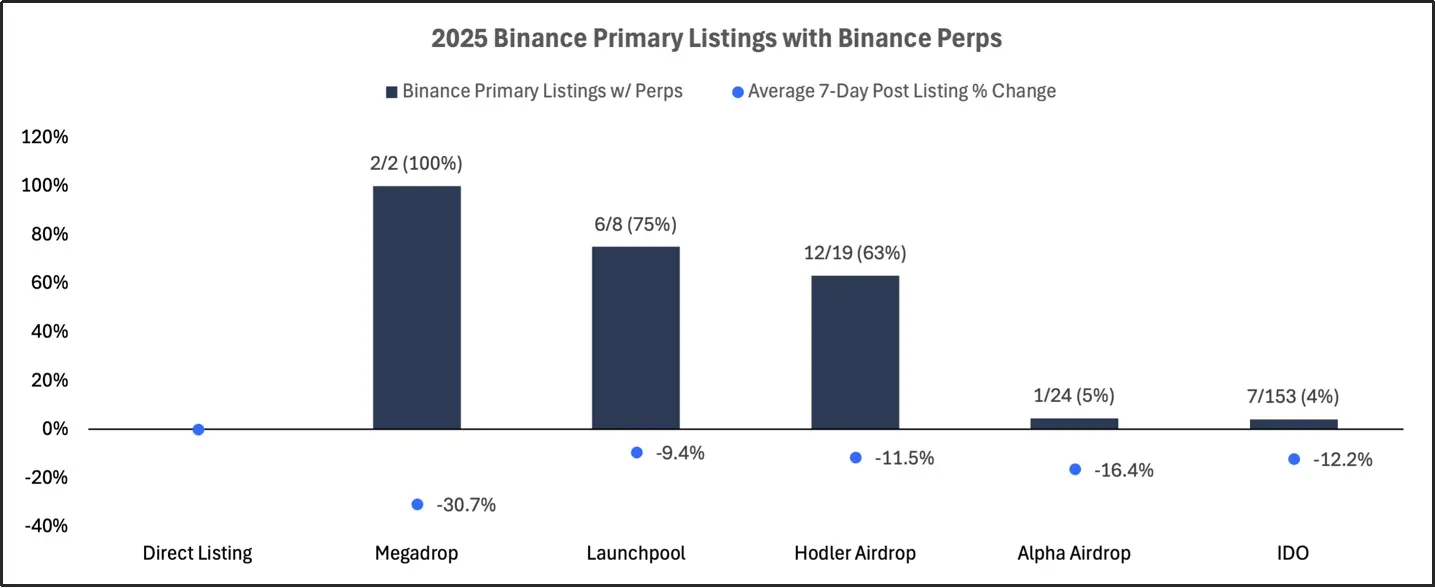
Projects on Binance in 2025 that Simultaneously List for the First Time and Launch Perpetual Contracts
The above chart analyzes the projects on Binance in 2025 that simultaneously launched perpetual contracts during their initial listings. The data shows that Binance clearly prefers to pair perpetual contract listings with first-day spot projects rather than Alpha airdrops or IDOs.
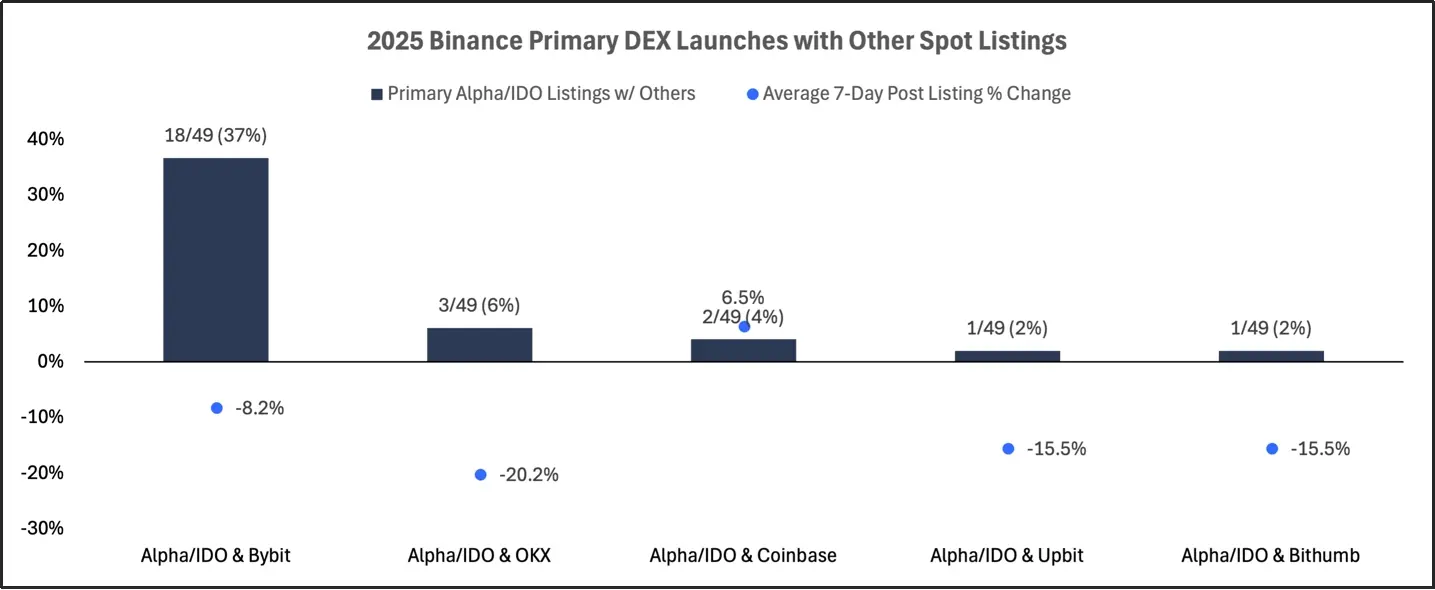
Frequency and Performance of Binance's First DEX Issuance Projects Concurrently Listing on Other Exchanges' Spot Markets in 2025
The above chart analyzes the frequency and performance of Binance's first DEX issuance projects (including Alpha airdrops and IDOs) that concurrently listed on spot markets of other major exchanges (such as Bybit, OKX, Coinbase, Upbit, and Bithumb). The performance of these joint listings is generally poor, with all exchanges showing negative average returns over 7 days, particularly pronounced declines observed on OKX, Upbit, and Bithumb.
- Conclusion
In the first half of 2025, the listing landscape of cryptocurrency exchanges underwent significant changes, driven by the rise of on-chain issuance projects, the dominance of secondary listings, and clearer segmentation of different valuation levels and platforms in listing pathways.
Binance still maintains a clear lead in total listing numbers, but its strategy has decisively shifted towards "on-chain priority" projects—especially Alpha airdrops and IDOs, which now account for the majority of new token issuances. However, the effectiveness of these projects varies widely: while Alpha airdrops can achieve large-scale issuance, they struggle in subsequent performance and conversion; IDOs, on the other hand, have become a more selective but better-performing pathway, particularly excelling in landing on Binance perpetual contracts. Among all exchanges, secondary listings consistently outperform initial issuances in both 7-day return rates and peak FDV ratios, reflecting the advantages of listing tokens after they have established initial liquidity and market presence. Notably, secondary listings from Binance, Coinbase, and Upbit show the strongest subsequent performance, while OKX and Bybit lag behind.
Valuation segmentation has now deeply integrated into the project systems of various exchanges: Binance's spot listings lean towards large-cap, high FDV tokens, while Alpha and IDO channels precisely target early-stage and growth-stage projects, respectively. This reflects a more targeted selection process in the token listing workflow and clear hierarchical differences in access to quality trading channels. Cross-exchange liquidity remains relatively rare and slow, with only a few projects from Binance successfully landing on the spot markets of other top-tier exchanges. Even when such conversions occur, they are often concentrated among high FDV projects, and their post-listing performance tends to be mediocre.
In summary, these trends highlight that the listing ecosystem is maturing, with unprecedented importance placed on project types, token development stages, and listing sequences. For project teams, investors, and exchanges, understanding these structural dynamics is key to navigating the increasingly layered pathway from token generation to long-term exchange liquidity.
Click to learn about job openings at ChainCatcher
Recommended Reading:
What Are On-Chain Whales Secretly Buying? Bitget Reveals Its Listing Mechanism
免责声明:本文章仅代表作者个人观点,不代表本平台的立场和观点。本文章仅供信息分享,不构成对任何人的任何投资建议。用户与作者之间的任何争议,与本平台无关。如网页中刊载的文章或图片涉及侵权,请提供相关的权利证明和身份证明发送邮件到support@aicoin.com,本平台相关工作人员将会进行核查。




